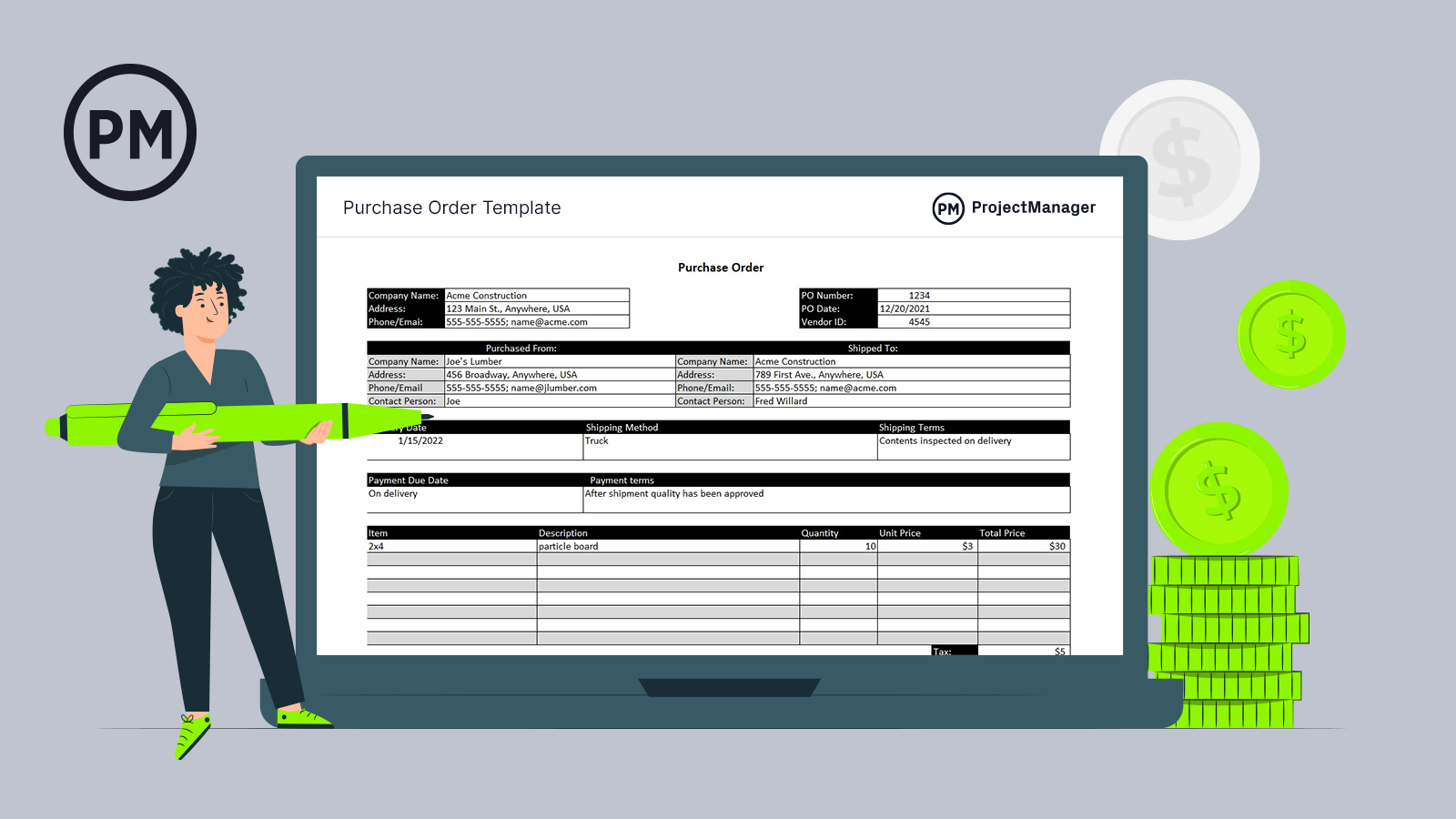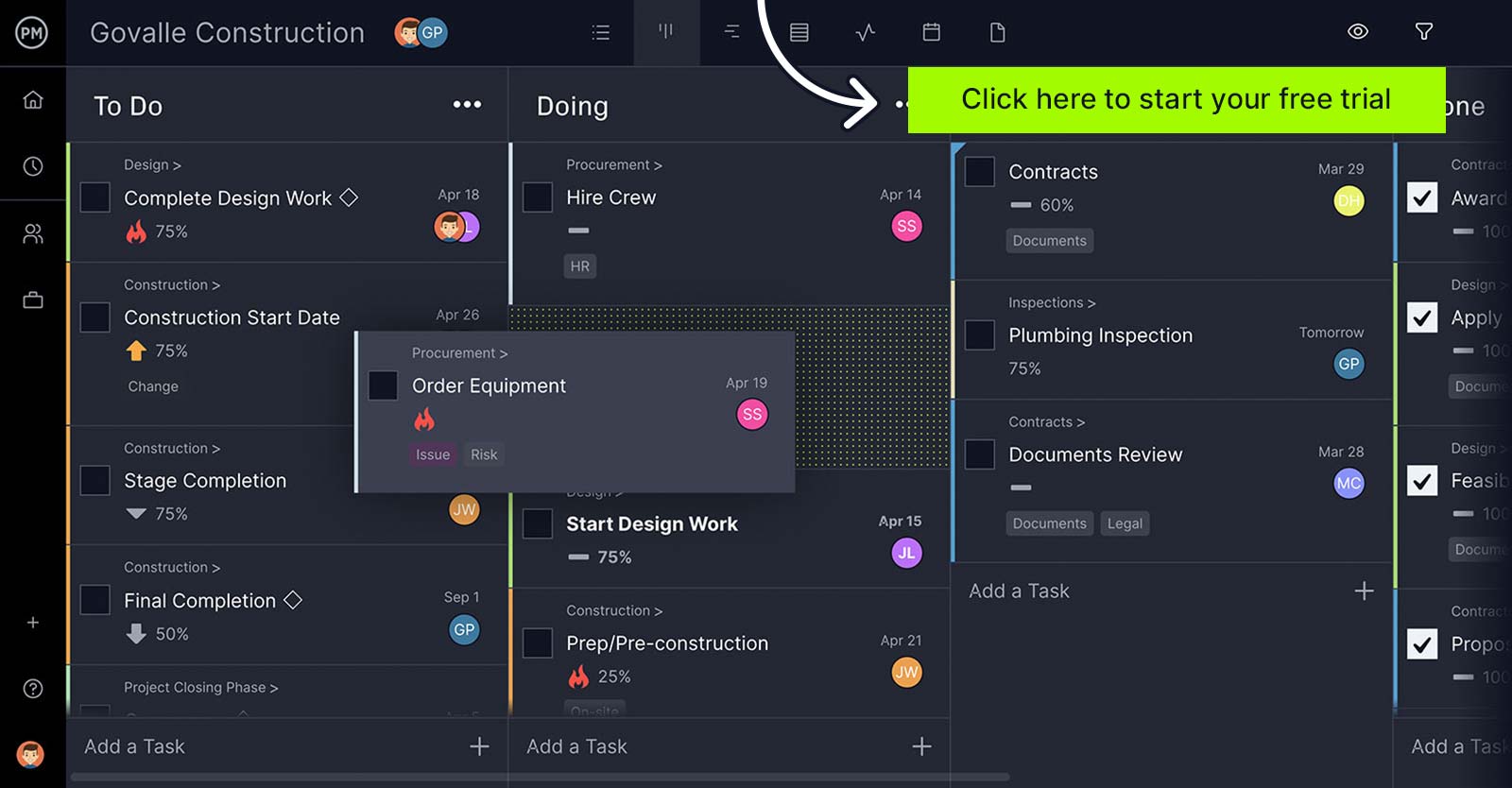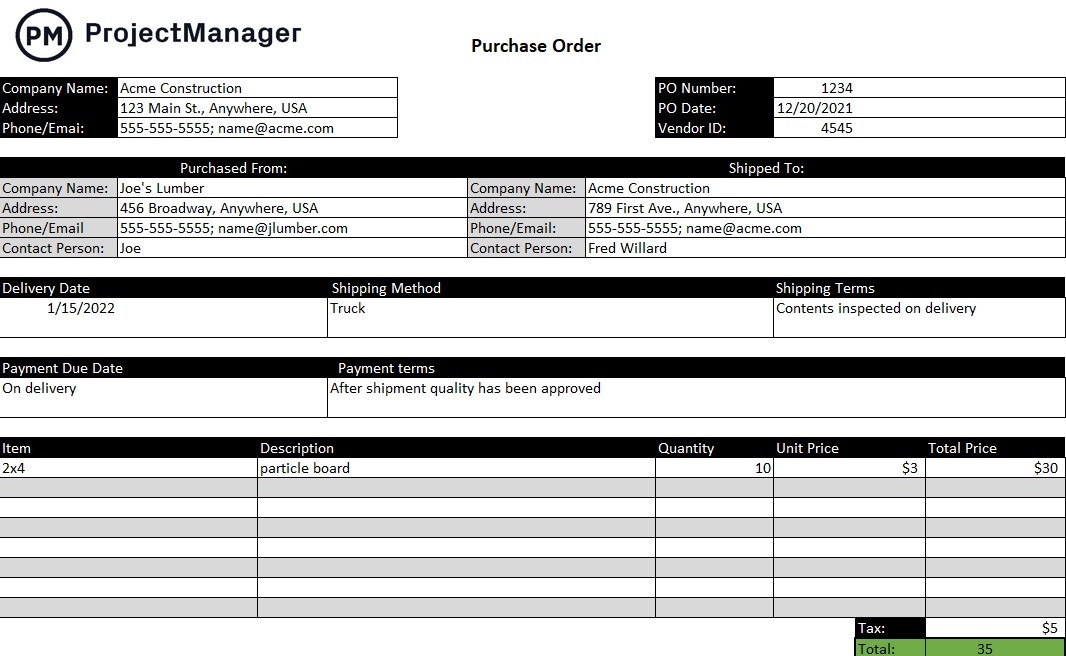Much of your project will be done in-house, but you’ll likely also contract with suppliers and others to deliver needed materials or services. How do you make sure that the goods are of the type you need, the quantity agreed upon and for the price that meets your financial constraints?
These parameters are all agreed upon through a purchase order. It’s a way to reach an agreement about the outside services required in the project to make sure you can schedule them into your project plan.

Get your free
Purchase Order Template
Use this free Purchase Order Template for Excel to manage your projects better.
Purchase Order vs. Purchase Requisition
Purchase orders and purchase requisitions are two different purchase management documents, and each plays an important role when managing your business purchases. The difference between them is that purchase requisitions are created whenever an employee needs internal approval to make a purchase, while purchase orders are sent to external parties such as suppliers whenever a purchase is made.
Purchase Order vs. Sales Order
A sales order is sent as a response to a purchase order. Whenever a buyer wants to make a purchase, he’ll send the supplier a purchase order. In return, the supplier will send a sales order, a similar document that confirms the price, quantity and other details about the sale.
We’ve created a free sales order template for Excel you can use to get started with this order management document.
Purchase Order vs. Purchase Invoice
Buyers send purchase orders to vendors to help keep track of their supply chain. Invoices, on the other hand, acts as payment request sent by the vendor to the buyer as soon as the order is fulfilled. In addition to listing the goods and services that were delivered, it also outlines how much money is owed. Invoices typically contain an identifying number, vendor information, payment details and how much is due.
ProjectManager has unlimited file storage to help you store and track your purchase orders. Plus, you can use its kanban boards and approval features to create a purchase order workflow that streamlines your procurement process. Get started for free.

What Should Be Included In a Purchase Order?
A purchase order varies in detail, but all share the following elements:
- A PO number to identify and track the order
- A PO date to capture when the order was agreed upon
- Vendor information, including the name of the vendor, shipping address and contact information
- Delivery date for when the goods or services are due
- Shipping method, if the goods are being shipped to a job site
- Any requirements for shipping
- Items that are included in the order
- The cost for each item
- The total cost of the entire shipment
- Taxes for total items purchased
- Payment due date
- Terms for payment
Your business might need further detail, which is fine, but if you have at least the above information in your purchase order, the owner and vendor are protected by contract. Therefore, to legally protect all parties, it’s critical that all the details of the transaction are clearly stated and agreed upon.
Why Are Purchase Orders Important?
The purchase order makes exactly what a buyer wants from a seller clear. It helps to avoid any confusion in terms of what a buyer wants, how much of it, what the cost will be, when and where it’ll be delivered and so forth.
More importantly, purchase orders help manufacturing businesses with the order management process because they help document all the orders that they’ve received from customers. This helps them know what they need to produce and also helps them keep track of their production inventory, which is critical for production planning, supply chain management and inventory management.
Benefits of Using Purchase Orders
Purchase orders protect both the buyer and the seller. For example, if a buyer doesn’t pay as agreed upon in the order, or the seller doesn’t fulfill the details of the order, they can pursue legal avenues to get their money, goods or financial compensation.
Of course, a lawsuit is not what any project manager wants. Therefore, the purchase order acts as a legal document to avoid any such disagreements by creating clear communication between both parties. It ensures that everyone involved in the project agrees upon the goods or services being procured.
Besides this, the use of purchase orders can also help you:
- Control excessive spending and duplication so you can keep costs within your project budget.
- Avoid misunderstandings or miscommunications with your suppliers, which is beneficial for supplier relationship management.
- Identify the cause of quality issues by pinpointing batches of raw materials or components.
- Compare prices among suppliers.
Purchase Order Template
We’ve created a free purchase order template you can download, customize and use for your projects. It helps you gather all the basic information you need for your purchase orders and can be easily shared with suppliers. Let’s see how it works with a purchase order example.
Purchase Order Example
Imagine a construction job, where Acme Construction realizes they need more particle boards. They contact their vendor, Joe’s Lumber, and discuss the order over the phone.

Coming to an agreement about price and delivery, Acme writes up a PO. They include their company name and contact information, create a PO number, date and vendor ID for Joe’s.
Vendor Contact Info
The next part of the purchase order is the contact info for the vendor, or who Acme is making the purchase from. This is followed by where the goods will be shipped, in this case, the job site. The approved delivery date is noted and the method of shipping, which in this case is by truck.
Payment Details
What follows are details about payment, when it’s due and if there are any terms. In this case, the payment is due upon delivery and only after the contact person listed in the shipping information has looked over and approved the wood.
Line Item Information
There’s a list of the goods, showing the item, describing it, the quantity, quoting the unit price and then a line total. For this order, there is only one line item, but there can be several. However many there are, they are totaled after the taxes for the purchase are added.
Additional Info
There is a box in which any additional information can be added. This might be how to reach the job site, how the goods need to be packed, etc. For this job, there’s no need for additional information, and the box can be left blank.
Signature
Finally, there’s a place for the vendor’s signature and the date on which the purchase order is signed. Once signed, this becomes a legally binding contract.
How to Create a Purchase Order
The purchase order process includes writing it up through to delivery. The PO process is broken down into the following steps.
1. Creation
Once a purchase requisition has been made, the purchase order is generated, usually by the procurement team or an administrator of the project.
2. Approval
If everyone involved agrees with the items, quantity, price and delivery requirements, the document is approved by the signature of the vendor agreeing to the terms.
3. Dispatch
The purchase order is sent to the vendor through whatever channel has been accepted. This can be done in person, by paper, sent by fax or email, etc.
4. Delivery
The vendor delivers the goods outlined in the purchase order. Those goods are examined and approved when the quality is acceptable, such as no defects or missing items. This is usually done by an administrator or procurement manager on the job site.
5. Closure
If everything is fine with the order, an approval invoice is sent to financing for payment processing. Once paid, the purchase order is closed.
Types of Purchase Orders
There are different types of purchase orders, which are used depending on how specific you want to be about your purchase payment terms, delivery schedule and quantities.
Standard Purchase Orders (SPO)
This is the most commonly used type of purchase order. It’s used whenever the buyer knows all the details about the purchase, such as the exact quantity, the delivery date and any additional information requested by the vendor.
Planned Purchase Orders (PPO)
A planned purchase order is just like a standard purchase order, but the delivery dates are tentative, and the quantity is based on an estimate of the future material requirements of the business. This purchase order is used whenever the buyer wants to buy large quantities over a time period, rather than a one-time purchase.
Blanket Purchase Orders (BPO)
Blanket purchase orders are typically used whenever there are recurring purchases that occur at uncertain time intervals. Blanket purchase orders have the same information as PPOs but the quantity and delivery dates remain uncertain.
Contract Purchase Orders (CPO)
Used whenever a supplier agrees on payment terms and conditions for future purchases from a buyer. This purchase order only specifies general guidelines.
Who Creates a Purchase Order?
Larger companies may have a purchasing department dedicated to overseeing purchase orders. Smaller companies may rely on operations managers, financial managers, office managers or even business owners to create the purchase order.
Specific teams may appoint designated individuals to create purchase orders. For example, software companies may appoint office managers to create purchase orders while a finance company may appoint financial managers to create purchase orders. How a company sets up its purchasing process will dictate who creates purchase orders.
Who Approves Purchase Orders?
Who approves purchase orders depends on the process in place within a given company. Larger companies may have fleshed-out purchasing processes consisting of approvals stemming from specific locations and departments. As an example, a software company may look to both directors and Chief Financial Officers (CFOs) to approve purchase orders.
Smaller companies may turn to either the CFO or CEO for purchase order approval which has the potential to slow down the process in some cases.
How ProjectManager Helps With the Purchase Order Process
ProjectManager is an award-winning project management tool that organizes work for greater efficiency. Using our software to streamline your purchase order process allows you to generate, track and close your purchase orders easier so you don’t have to get pulled away from managing the project.
One of our project views is the kanban board, which visualizes workflow. The board is a series of columns with cards stacked underneath that can be dragged and dropped from one column to the next as they move through the purchase order process.

Once you have a procurement need, you can use the customizable columns to outline your five-step purchase order process. Create a card to represent the purchase order. Attach the actual purchase order to the card and move it across the board as it is approved, delivered and closed.
Your procurement can be tracked at a glance to make sure it’s delivered on time by creating a due date on the card. Add tags to designate it to a department or project and make it easy to find in a search. You can even assign the card to your procurement manager and comment to keep the lines of communication open.
Related Content
- Free Sales Order Template for Excel
- Order Fulfillment: Process, Models & Documentation
- How to Make a Production Order for Manufacturing
ProjectManager is an award-winning tool that helps you stay organized to improve productivity. It can manage your purchasing, planning, monitoring and reporting on projects. Join organizations like NASA, which already use our tool to run successful projects. Try this free 30-day trial offer today.

